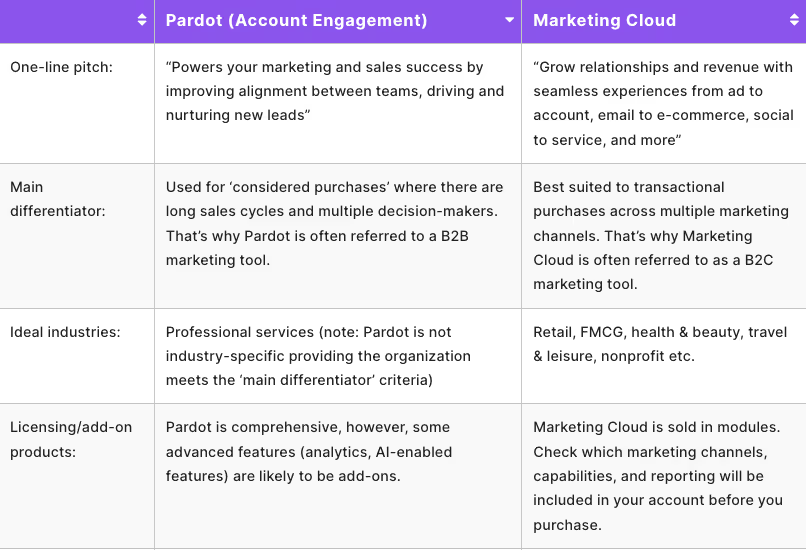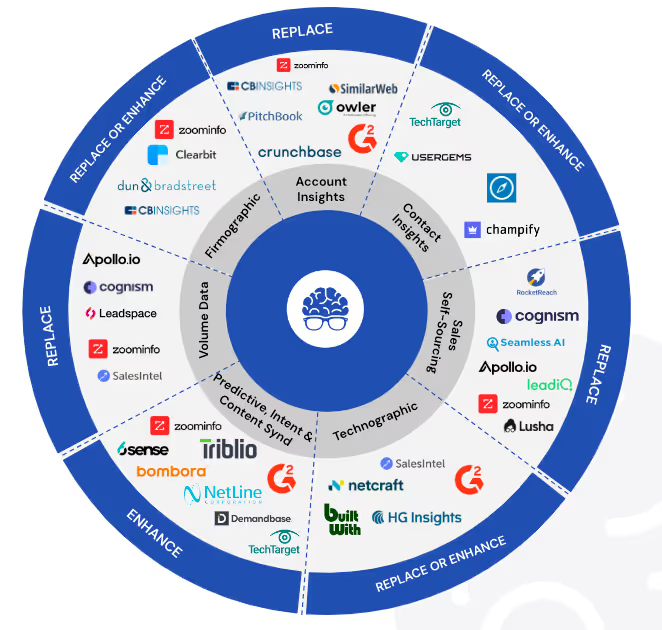The rebranding of Pardot to "Marketing Cloud Account Engagement" by Salesforce has introduced significant challenges and widespread confusion among its user base including yours truly. Originally, Salesforce's distinct marketing solutions—Pardot and Marketing Cloud—served specific market segments with tailored functionalities, Pardot focusing on B2B marketing automation and Marketing Cloud on high-volume B2C campaigns. The renaming, however, has blurred these once-clear distinctions and left me puzzled about the future.
As a result, users now face difficulties in discerning which platform better suits their strategic requirements, complicating the decision-making process. This confusion is not just a minor inconvenience; it fundamentally impacts users’ ability to choose the most appropriate tools for their marketing strategies, potentially leading to suboptimal investment in technologies that do not align with their operational goals. The overlap in product functionalities that this rebranding has created can cause firms to either double-dip in features or miss out on critical capabilities, thus hampering their marketing effectiveness and efficiency. As a true believer in what Salesforce has built from a CRM perspective, it should be concerning that I do not have the same loyalty when is comes to the MAS side of the house. In the following article I explore
Confusion in the Salesforce Ecosystem
The Salesforce ecosystem, which historically segmented its marketing tools to cater distinctly to B2B and B2C audiences, has encountered a wave of confusion following the rebranding of Pardot to Marketing Cloud Account Engagement. Originally, Pardot was crafted with a focus on B2B interactions, adept at managing the complexities of lengthy sales cycles and the intricacies involved in dealing with multiple decision-makers within a business setting. In contrast, Marketing Cloud was engineered to support B2C marketers, adept at handling high-volume, transactional engagements across multiple channels, from digital advertising to direct customer communications.
This well-defined separation has become muddled with the rebranding, leading to an overlap in the perceived functionalities of these tools. Customers are now facing a dilemma, as they struggle to pinpoint which product aligns best with their specific marketing needs. The challenge lies in the discernment of the unique advantages each platform is supposed to offer. Instead of clear, strategic decision-making, businesses find themselves navigating through fragmented information and ambiguous product descriptions. This confusion is significantly exacerbated by Salesforce’s marketing approaches, which tend to group both products under a single banner without adequately distinguishing the unique strengths or intended user bases of each tool. As a result, companies are at risk of selecting platforms that may not optimally fulfill their requirements, potentially leading to inefficient resource use and less effective marketing outcomes. This scenario underscores the necessity for Salesforce to refine its product communication, ensuring that each platform’s capabilities, ideal use cases, and target audiences are transparently and distinctly presented to aid customers in making informed decisions that truly enhance their marketing strategies.

Integration Challenges
Additionally, despite the shared branding suggesting a seamless integration, Pardot and Marketing Cloud do not integrate effortlessly within the broader Salesforce ecosystem. Users frequently encounter integration issues that can create significant technical challenges, necessitating additional resources for management, maintenance, and troubleshooting. These integration problems often require specialized skills and additional manpower, increasing operational costs and complexity. The expectation of a unified platform experience leads to frustration when users encounter these integration roadblocks, as they detract significantly from the overall user experience and efficiency of the system. A recent post by RevOps thought leader Jacki Leahy, spoke to the frustration of users and specialists in the space.

Impact on User Experience and Efficiency
These integration challenges not only increase costs and complexity but also negatively impact the user experience. The disjointed nature of the integration can lead to data silos, inconsistent user interfaces, and a fragmented strategy execution, all of which hamper effective marketing operations. The need for constant adjustments and fixes can divert attention from strategic marketing activities to operational troubleshooting, thus reducing overall marketing efficiency.
The overlapping functionalities and integration issues between Pardot and Marketing Cloud present substantial challenges for users. These include inefficient resource utilization, decision-making difficulties, increased operational costs, and a compromised user experience. Salesforce needs to address these issues by clarifying the distinct advantages of each platform and improving integration capabilities to ensure that users can fully leverage the intended benefits of each product without undue complexity or cost.
Viable Alternatives
For many organizations, especially those that do not require deep integration with Salesforce, looking at alternatives might offer better value and functionality. Tools like HubSpot, Marketo, and ActiveCampaign present themselves as capable competitors, often offering more intuitive user experiences and better integration capabilities with other systems.
- HubSpot - Known for its user-friendly interface and broad range of functionalities, HubSpot serves both B2B and B2C marketers effectively. It offers deep insights into customer interactions and an all-in-one platform for inbound marketing, sales, customer service, and CRM.
- Marketo - A strong contender for larger enterprises with complex marketing needs, Marketo provides sophisticated campaign management and integration capabilities, making it suitable for detailed analytics and automation strategies.
- ActiveCampaign - As a more cost-effective alternative, ActiveCampaign offers robust automation and customer relationship management features that cater to small to mid-sized businesses, making it a great tool for those looking to get high functionality at a lower cost.
- Mailchimp - Initially popular as an email marketing tool, Mailchimp has expanded into a full marketing platform that’s particularly accessible for small businesses looking to start with automation.
- Infusionsoft by Keap - Best for small businesses, Infusionsoft offers CRM, marketing automation, sales automation, and e-commerce functionalities all in one platform, though it has a steeper learning curve.

Parting Thoughts
To address the confusion stemming from the rebranding of Pardot to Marketing Cloud Account Engagement, and the resulting overlap with Marketing Cloud, Salesforce should implement a multi-faceted solution focused on clarity, differentiation, and enhanced integration.
- Clear and Distinct Positioning: Salesforce should embark on a robust educational campaign aimed at clearly delineating the differences between Marketing Cloud Account Engagement and Marketing Cloud. This campaign should include detailed guides, webinars, and case studies that illustrate the specific scenarios and business types each product is designed for. This clarity will help users understand which tool aligns best with their marketing needs and strategic goals.
- Enhanced Integration Capabilities: Recognizing the integration challenges between Pardot and the broader Salesforce ecosystem, Salesforce should develop and offer enhanced, streamlined integration solutions. These should focus on reducing the technical barriers that currently exist, facilitating a smoother data flow between Salesforce CRM and both marketing platforms. Improved integration tools should be intuitive, requiring less specialized knowledge to manage, thereby lowering the cost and complexity of operations.
- User-Centric Development: Salesforce should increase its engagement with the end-user community to gather feedback directly from those who use their marketing solutions daily. This feedback should then inform ongoing product development to ensure that updates and new features address real user needs and pain points, rather than merely expanding functionality in ways that add to the confusion.
- Segment-Specific Marketing Strategies: Salesforce needs to tailor its marketing strategies to the distinct segments served by each platform. By aligning marketing messages with the unique needs of B2B and B2C marketers, Salesforce can prevent the current confusion and overlap in platform perception. This targeted marketing should highlight the specific benefits of each platform, making it easier for businesses to make informed decisions based on their particular marketing environments.
- Transparency in Product Evolution: As Salesforce continues to evolve its marketing platforms, it must maintain transparency about the changes and enhancements being made. This includes providing users with advance notice of significant updates, clear explanations of how these changes will affect existing functionalities, and guidance on adapting to new features.
By implementing these strategies, Salesforce can mitigate the current confusion and dissatisfaction among users, ultimately enhancing user experience, fostering loyalty, and maintaining its position as a leader in both B2B and B2C marketing solutions. This proactive approach will not only clarify the product offerings but also demonstrate Salesforce's commitment to its user base's success and satisfaction.
------------------------------------------------------------------------------------------------
Disclaimer: The views and opinions expressed in this article are those of Derek Rahn, VP of Demand Generation at LeadGenius, and do not necessarily reflect the official policy or position of LeadGenius or any other agency, organization, employer, or company.




